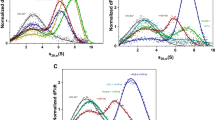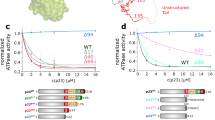Abstract
SIGNALLING by steroid hormones is mediated by receptor proteins that bind hormonal ligands and regulate the transcription of specific genes. The heat-shock protein hsp90 seems to associate selectively with unliganded receptors (aporeceptors), but it has not been determined whether this interaction affects receptor function in vivo. To address the role of hsp90, we have taken advantage of the capacity of mammalian steroid receptors to function in yeast1–4. We constructed a strain of Saccharomyces cerevisiae in which hsp90 expression was regulatable and could be reduced more than 20-fold relative to wild type. At low levels of hsp90, aporeceptors seem to be mostly hsp90-free, yet fail to enhance transcription; on hormone addition, the receptors are activated but with markedly reduced efficiency. Thus hsp90 does not inhibit receptor function solely by steric interference; rather, hsp90 seems to facilitate the subsequent response of the aporeceptor to the hormonal signal. This is the first biological evidence that hsp90 acts in the signal transduction pathway for steroid receptors.
This is a preview of subscription content, access via your institution
Access options
Subscribe to this journal
Receive 51 print issues and online access
$199.00 per year
only $3.90 per issue
Buy this article
- Purchase on Springer Link
- Instant access to full article PDF
Prices may be subject to local taxes which are calculated during checkout
Similar content being viewed by others
References
Schena, M. & Yamamoto, K. R. Science 241, 965–967 (1988).
Metzger, D., White, J. H. & Chambon, P. Nature 334, 31–36 (1988).
McDonnell, D. P., Pike, J. W., Drutz, D. J., Butt, T. R. & O'Malley, B. W. Molec. Cell. Biol. 9, 3517–3523 (1989).
Picard, D., Schena, M. & Yamamoto, K. R. Gene 86, 257–261 (1990).
Borkovich, K. A., Farrelly, F. W., Finkelstein, D. B., Taulien, J. & Lindquist, S. Molec. cell. Biol. 9, 3919–3930 (1989).
Lindquist, S. & Craig, E. A. A. Rev. Genet. 22, 631–677 (1988).
Groyer, A., Schweizer-Groyer, G., Cadepond, F., Mariller, M. & Baulieu, E.-E. Nature 328, 624–626 (1987).
Sanchez, E. R. et al. J. biol. Chem. 262, 6986–6991 (1987).
Willmann, T. & Beato, M. Nature 324, 688–691 (1986).
Klein-Hitpass, L. et al. Cell 60, 247–257 (1990).
Bresnick, E. H., Dalman, F. C., Sanchez, E. R. & Pratt, W. B. J. biol. Chem. 264, 4992–4997 (1989).
Picard, D., Salser, S. J. & Yamamoto, K. R. Cell 54, 1073–1080 (1988).
Picard, D., Kumar, V., Chambon, P. & Yamamoto, K. R. Cell Reg. 1, 291–299 (1990).
Eilers, M., Picard, D., Yamamoto, K. R. & Bishop, J. M. Nature 340, 66–68 (1989).
Pratt, W. B. et al. J. biol. Chem. 263, 267–273 (1988).
Dalman, F. C. et al. J. biol. Chem. 264, 19815–19821 (1989).
Howard, K. J., Holley, S. J., Yamamoto, K. R. & Distelhorst, C. W. J. biol. Chem., 265, 11928–11930 (1990).
Godowski, P. J., Rusconi, S., Miesfeld, R. & Yamamoto, K. R. Nature 325, 365–368 (1987).
Yamamoto, K. R., Godowski, P. J. & Picard, D. Cold Spring Harbor Symp. quant Biol. 53, 803–811 (1988).
Johnston, M. & Davis, R. W. Molec. cell. Biol. 4, 1440–1448 (1984).
Sikorski, R. S. & Hieter, P. Genetics 122, 19–27 (1989).
Schena, M., Freedman, L. P. & Yamamoto, K. R. Genes Dev. 3, 1590–1601 (1989).
Patel, P. D., Sherman, T. G., Goldman, D. J. & Watson, S. J. Molec. Endocr. 3, 1877–1885 (1989).
Green, S. et al. Nature 320, 134–139 (1986).
Tora, L. et al. EMBO J. 8, 1981–1986 (1989).
Klein-Hitpass, L., Schorpp, M., Wagner, U. & Ryffel, G. U. Cell 46, 1053–1061 (1986).
Gametchu, B. & Harrison, R. W. Endocrinology 114, 274–279 (1984).
Okret, S., Wikström, A.-C., Wrange, Ö., Andersson, B. & Gustafsson, J.-Å. Proc. natn. Acad. Sci. U.S.A. 81, 1609–1613 (1984).
Simons, S. S. Jr, Thompson, E. B. & Johnson, D. F. Biochem. biophys. Res. Commun. 86, 793–800 (1979).
Yocum, R. R., Hanley, S., West, R. W. Jr & Ptashne, M. Molec. cell. Biol. 4, 1985–1998 (1984).
Author information
Authors and Affiliations
Rights and permissions
About this article
Cite this article
Picard, D., Khursheed, B., Garabedian, M. et al. Reduced levels of hsp90 compromise steroid receptor action in vivo. Nature 348, 166–168 (1990). https://doi.org/10.1038/348166a0
Received:
Accepted:
Issue Date:
DOI: https://doi.org/10.1038/348166a0
This article is cited by
-
The effectiveness of glucocorticoid treatment in post-COVID-19 pulmonary involvement
Pneumonia (2024)
-
Tenth International Symposium on the Hsp90 chaperone machine
Cell Stress and Chaperones (2023)
-
Translational reprogramming in response to accumulating stressors ensures critical threshold levels of Hsp90 for mammalian life
Nature Communications (2022)
-
Structural elements in the flexible tail of the co-chaperone p23 coordinate client binding and progression of the Hsp90 chaperone cycle
Nature Communications (2021)
-
Conformational dynamics modulate the catalytic activity of the molecular chaperone Hsp90
Nature Communications (2020)
Comments
By submitting a comment you agree to abide by our Terms and Community Guidelines. If you find something abusive or that does not comply with our terms or guidelines please flag it as inappropriate.



